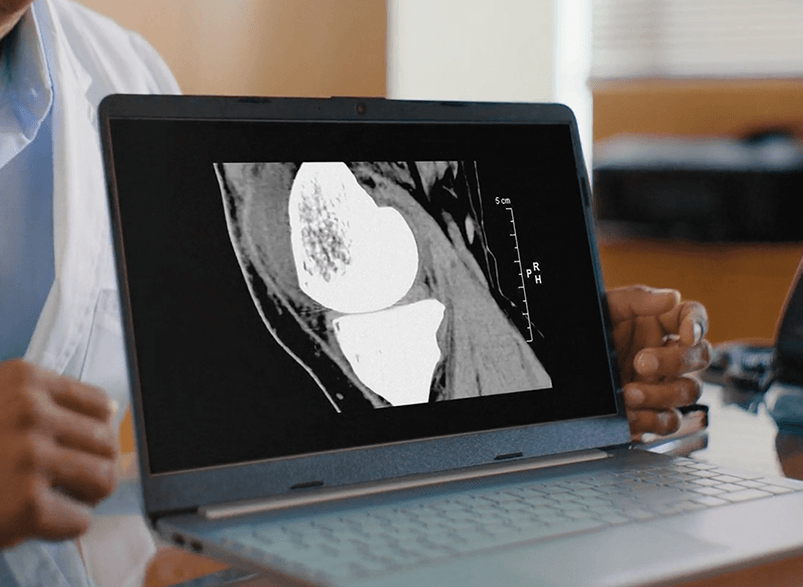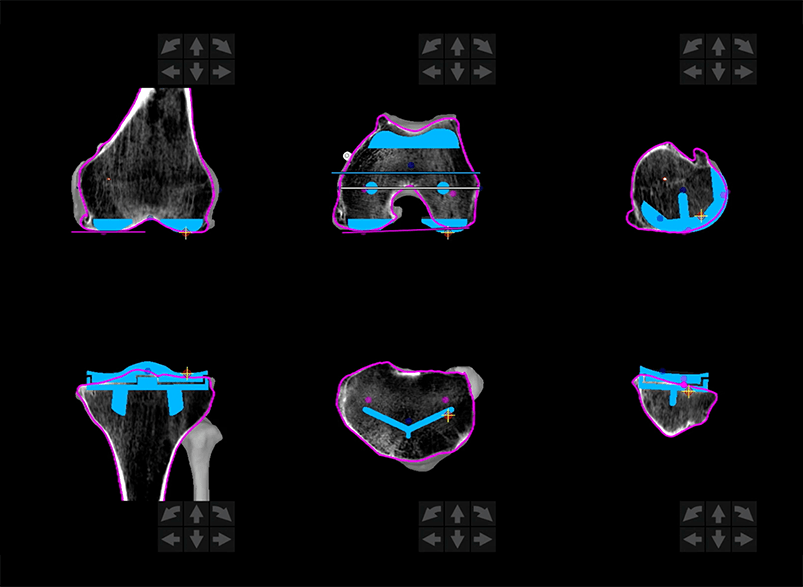Lindsey Vonn is an Olympic gold alpine medalist, best-selling author, entrepreneur and philanthropist. She is also a Mako Partial Knee replacement patient.
When knee pain got in the way, I made a plan.
Lindsey Vonn's
knee pain journey
Mako robotic-arm assisted surgery helps your surgeon provide a personalized surgical experience based on your specific diagnosis and anatomy. Mako can be used for total knee replacements, partial knee replacements, total hip replacements and spine surgery. Here’s how it works:
The Mako Difference
Scan.
Before surgery, a CT scan is taken and used to develop a 3D virtual model of your unique anatomy. This allows your surgeon to evaluate your bone structure, disease severity, alignment and even the surrounding bone and tissue.

Plan.
Mako's 3D virtual model of your unique anatomy enables your surgeon to create a personalized surgery plan.

Mako Can.
During surgery, your surgeon guides Mako's robotic-arm, which uses AccuStopTM technology, so he/she can align the robotic-arm to your personalized surgical plan.
In hip and knee surgeries, Mako has been shown to help protect healthy bone1-5 and lead to better outcomes, like less pain and shorter recovery times6-8 compared to traditional surgery. Mako is designed to help you get back to the things you love.

Discover surgeons near you to see if surgery is an option for you.
Explore
Mako Robotic-Arm assisted surgery


Mako Partial Knee Replacement
Learn how Mako Partial Knee has been shown to shorten hospital stay when compared to manual procedures.6

Mako Spine
Learn how Mako Spine is designed to give surgeons confidence that they're executing their procedure to your personalized surgical plan.

References:
- Suarez-Ahedo, C; Gui, C; Martin, T; Chandrasekaran, S; Domb, B. Robotic arm assisted total hip arthoplasty results in smaller acetabular cup size in relation to the femoral head size: A Matched-Pair Controlled Study. Hip Int. 2017; 27 (2): 147-152.
- Haddad, F.S, et al. Iatrogenic Bone and Soft Tissue Trauma in Robotic-Arm Assisted Total Knee Arthroplasty Compared With Conventional Jig-Based Total Knee Arthroplasty: A Prospective Cohort Study and Validation of a New Classification System. J Arthroplasty. 2018 Aug;33(8):2496-2501. Epub 2018 Mar 27.
- Hozack WJ, Chen AF, Khlopas A, et al. Multicenter analysis of outcomes after robotic-arm assisted total knee arthroplasty. Presented at: The Knee Society (TKS) 2018 Members Meeting; September 20-22, 2018; Saint Louis, MO.
- Banks, Scott A, PhD. Haptic Robotics Enable a Systems Approach to Design of a Minimally Invasive Modular Knee Arthroplasty. Am J Orthop. 2009;38(2 suppl):23-27. February 2009.
- Hampp E, Chang TC, Pearle A. Robotic partial knee arthroplasty demonstrated greater bone preservation compared to robotic total knee arthroplasty. Annual Orthopaedic Research Society. Austin, TX. 2-5 Feb 2019.
- Kayani B, Konan S, Tahmassebi J, Rowan F, Haddad F. An assessment of early functional rehabilitation and hospital discharge in conventional versus robotic-arm assisted unicompartmental knee arthroplasty: A PROSPECTIVE COHORT STUDY Bone Joint J 2019;101-B:24–33
- Kayani B, Konan S, Tahmassebi J, Pietrzak J, Haddad F. Robotic-arm assisted total knee arthroplasty is associated with improved early functional recovery and reduced time to hospital discharge compared with conventional jig-based total knee arthroplasty: A PROSPECTIVE COHORT STUDY Bone and Joint Journal: 2018; 100-B:930–7.
- Shibanuma N, Ishida K, Matsumoto T, et al. Early postoperative clinical recovery of robotic arm-assisted vs. image-based navigated Total hip Arthroplasty. BMC Musculoskelet Disord. 2021;22(1):314.
- Fontalis A, Kayani B, Asokan A, et al. Inflammatory Response in Robotic-Arm-Assisted Versus Conventional Jig-Based TKA and the Correlation with Early Functional Outcomes: Results of a Prospective Randomized Controlled Trial. J Bone Joint Surg Am. 2022;104(21):1905-1914. doi:10.2106/JBJS.22.00167

